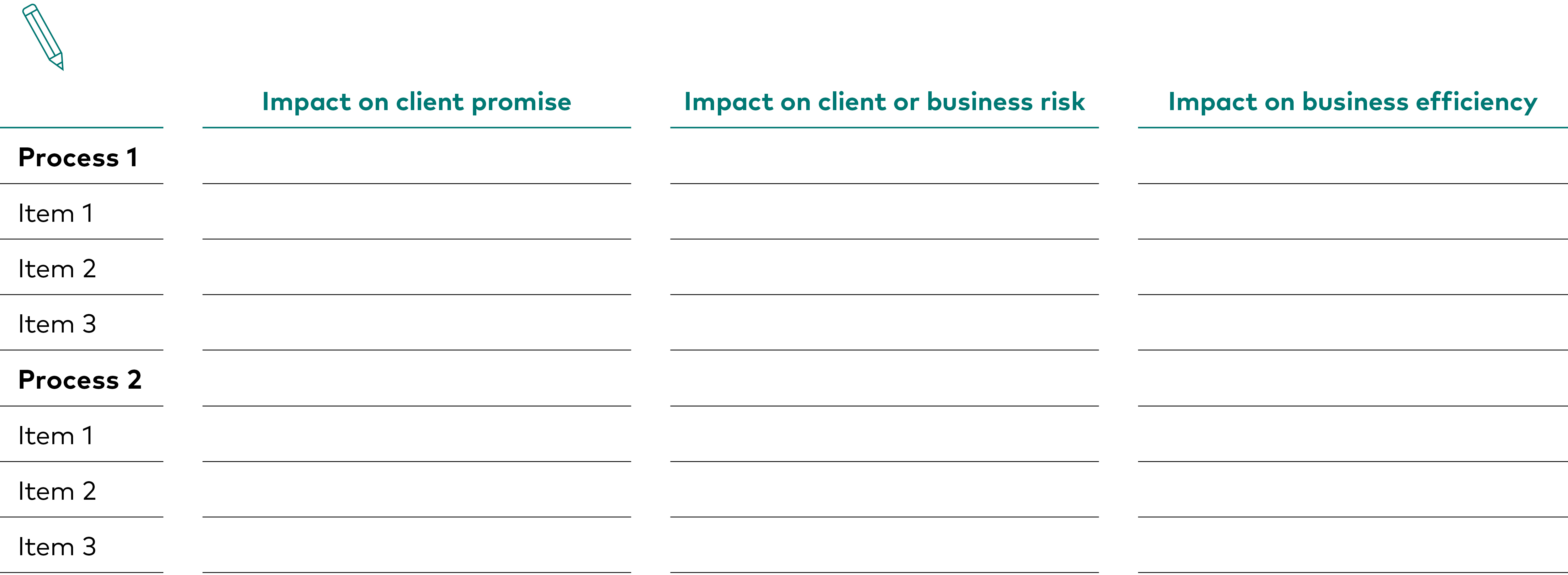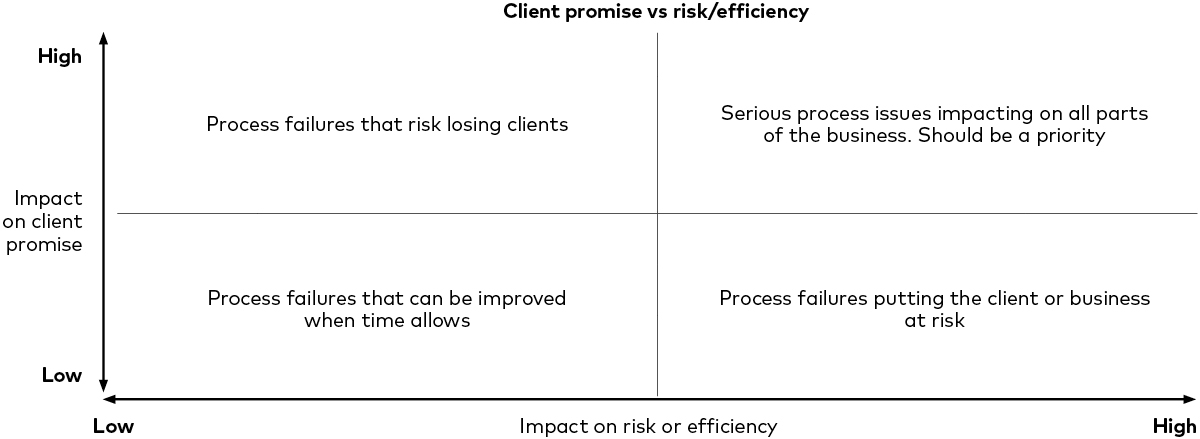How to build trust
How do you gain – and maintain – client confidence? This video provides methods and strategies to put into practice with your clients.
In this article we offer guidance to help you implement change within your organisation, step by step, by considering:
How to create positive change
Deciding what to change
Working out how to change
How to measure improvement
As you set about improving your processes, it is worthwhile creating an environment where your people feel positively supported and embrace change. Seeking change in an organisation can make staff feel uneasy, threatened or criticised. Work in partnership with your staff as stakeholders in your business to create change, rather than dictate this to them.
To create a positive atmosphere:
Ask for input from your staff. Engage with your people to identify areas for improvement and show genuine interest in their answers. Consult with them.
Support change on a personal level. Recognise that some people may fear change whilst others embrace it. Make efforts to support your staff as they embark on personal change.
Create a “beacon”: a description of your idea of a perfect business, so that clients and staff have a shared understanding of what the business aspires to be. Ask yourself, “how do we make this a great place for our clients?” and “how do we make this a great place to work?” Commit to making your business great.
Recognise that change will take time and that anxiety and resistance can be a natural part of the change process.
Remember the people as well as the process. You will need aligned and engaged people to deliver your processes.
Expect false starts and hurdles. Resistance is a positive sign that people are taking change seriously. Embrace the engagement and discuss concerns and how you can overcome them.
Expect productivity to slow when people are transitioning to the new way of doing things.
Start with small wins. Set some achievable milestones, achieve them and build momentum.
Take time to explain your aspirations and goals, and don’t expect everyone to “get it” immediately. Likewise, your sense of urgency may not be matched by others. Make sure your “beacon” is reinforced.
Personalise the benefit. Your people will want to know what’s in it for them; make sure you have a positive answer.
Experience can be your worst enemy, so develop novel new ways of trying new things and rewarding success.
Time your changes. Think about timing “nice-to-haves” with those that are time dependent (i.e. regulatory changes).
Be realistic. The change you want will be harder and more complex than you think, so set realistic goals.
Most businesses are full of processes that have simply evolved over time. Before leaping into action, it is important to think seriously about what you need to change and why, by considering those processes that are most important to you.
To map your processes, break them down into three typical types:
These can then be broken down further into:
Keeping your promise requires excellence in both categories of process.
Client-facing processes
Gather your teams to brainstorm the activities you undertake with clients and group these into themes. For example:
Support processes
You also need to identify those broader processes that underpin your business. For example:

With your team, identify and write down everything you currently do in the business. Using sticky notes so that you can cover a wall with your brainstorming notes is a good idea – you can then use these to group them later on.
You will also need to identify the key elements of each task that make up the process. Try and involve everyone who touches the process as they are best placed to identify the required tasks.
Detail the tasks to a good level but not yet to step-by-step actions – these will come later. You are currently just trying to identify those areas that may hold the key to improvements.
Then you will need to score your processes.
The problem areas, if you have any, might be obvious, especially if you have sought customer feedback. Resist the temptation to dive into action, but delve deeper to discover if there are any serious issues or root causes to the obvious areas of needed improvement.
Using a score matrix, like the one below, will enable you to have a sense of how each part of each process influences the client experience and business performance. You can use your sticky notes to consider each part of each process separately and award a score in each of the three categories. From this, it may become apparent where the key risks to the business lie, or if certain processes are problematic in all areas.
Engage your team in an honest assessment to score each item.

Score each process and task according to its impact: either positive, neutral or negative.
Positive: the process works well in all instances and is having a positive impact.
Neutral: the process works sometimes, but sometimes fails to meet clients’ expectations, introduces a risk or is inefficient.
Negative: in most cases the process fails and affects client experience, risk or efficiency.
Plotting each process (or part of) on the below grid can help to prioritise how you tackle improvements. This visual makes it clearer to see which processes have the greatest impact and are therefore of the highest importance.


Include all your teams in this discussion so that people take ownership for the problems and work on those items most important to the business. You may find front line staff are tempted to prioritise items they know will improve the client experience whilst making their life easier, whereas support teams will be keen to ensure that the business is operating safely and efficiently (whilst making certain any legalities are in place). With this in mind, moderating between the various business functions to ensure that there is an agreed set of priorities for the whole team is a sensible approach.
As we mentioned at the beginning of this article, your business’s ambition to be “great” (as opposed to simply “good”) can be described as a “beacon” position – a state to aspire to be. Your beacon defines what you need to achieve to be a safe and profitable business that wholly satisfies and delights its clients. So, how do you get to this position?
Having now identified which processes have the most impact on your business, you can work out how to improve them. You will need to examine:
How does the process work currently?
How would an ideal process work?
Examine and record how the current process actually works in practice. Think about this honestly – how it really is, not how it should be. The aim of this exercise is to create a clear picture of the existing situation so that you can:
Understand how you currently operate;
Understand where training needs might emerge;
Identify process bottlenecks;
Identify waste;
Identify risks to the client or business;
Identify any client interaction points that are failing.
Your people understand the workings of your processes the best, so seek input from them. Positively challenge any defensiveness with the aim of improving client and business experience. It is also good practice to seek input from your clients and any other third parties involved in the process – for example, outsourcing partners.
Make a process map by considering each and every step in the process. As you map each step, consider and record any dependencies for that step, or what that step entails.
Identify dependencies through numbering them as you create the process map. You then need to find the roots of each dependency, as failure can often be deep rooted and not immediately obvious. To help find the roots, consider these questions:
What enables this step to happen?
On whom do we need to rely for this step to happen?
What data is needed for this step to happen?
What does this step enable somebody else to do?
Once the mapping process has been completed, ask those involved in the process (both internally and externally) to verify that the process map is an accurate reflection of the current state.
The map can then be used to identify:
Value: steps that add value to the end result can be marked and recorded as important in the improvement process.
Waste: steps that appear repetitive, or as a result of failure elsewhere, should be marked as wasteful. If undertaking in-depth process mapping, the cost of these waste steps can be identified or estimated to calculate the potential efficiency savings and inform the business case for process change.
Risk: tag steps that mitigate or introduce client or business risk. Controlling risk is a function that should be embedded into process improvements and not be an afterthought.
Start with the end in mind and work backwards. Consider the questions we looked at above (decide what to change):
How do we meet the promise we made to the client?
How do we manage risks for the client and the business?
How do we operate as efficiently as possible?
Comparing your current process map with the “ideal” process map will help you identify the key improvements required. You may need to cut wasteful steps or introduce new ones to mitigate risk or improve client experience. It's difficult to improve processes in one area without changing processes in another; organisations are organic, with many interconnecting parts. This highlights the importance of involving people from all areas of the business in process improvement.
Starting from “ideal” and working back will ensure that your changes don’t fall short. At each step in the “ideal” process ask yourself the “how, how, how?” question to get you to the root of your requirements:
How can we make sure this step is executed flawlessly?
How can we make sure this step is carried out as safely as possible?
How can we make sure this step is carried out as efficiently as possible?
Consider, also, the requirements against the capability of the firm. Long-term business success and profitability necessitates that you only make promises that your business can keep. Mapping the requirements to your promise may reveal requirements beyond your current capabilities. At this point you need to decide if that requirement should be part of your business or if your business can master that requirement.
Consider each step of the process and what action to take. These points can include:
Standardise to aid consistency and reliability;
Improve where a minor adjustment to the process will suffice;
Re-design where a more radical approach is required;
Stop if it is adding more value;
Collaborate if teamwork would help;
Simplify if too complex;
Automate if suitable technology can be sourced.
Draw up a process improvement plan when you have considered all the options. This should include the following items:
The process to be improved (title);
The purpose of the process;
What benefits improving the process will bring (internally and externally);
How you will measure the process;
Improvement (quality, quantity, cost or time);
The process improvement owner;
The process improvement constituents (those involved);
Each process to be changed – including activities and timescales;
Related dependencies (training, finance, compliance etc.).

The adage “people buy people” is true, but people also buy trust, reliability and results. Therefore, keep your people for those elements of the client relationship that are impossible to deliver with technology and let technology do as much of the rest as possible.
The most successful advice businesses understand what to automate. Deploy technology to do the heavy lifting, leaving the adviser to focus on personal and compelling client discussion and interaction.
When mapping your processes, consider which steps are particularly repetitive and/or complex and prone to human error. Target these to see if a reliable technology solution can be deployed. This should improve efficiency, reduce risk and support reliable delivery of the client promise.
In our paper, “Quantifying the investor’s view on human and robo-advice: the value, benefits and opportunities”, the benefit of automating functions is discussed in detail alongside a commentary on the research findings. It states: “Across all generations, wealth levels and advice-delivery types, clients suggest that human financial advisers should consider automation to outsource portfolio construction and functional tasks.”
We have seen through this research that it is the tasks that give the most emotional or financial value that clients prefer to be carried out by humans. Automate functions where there is no value to be added by humans, and where doing so is quicker and avoids the potential for human error.

Improvement can often take longer and will be more challenging than you first imagined. Ensuring that you stay on course and deliver hoped-for improvements and client benefits requires that you measure and monitor your progress. Only if you measure it can you really improve it.
We have described the process to follow to undertake this effectively in a separate paper, Measuring Improvement. We would advise you consult this paper for a full briefing into methods to follow, including:
Recording your current state as a benchmark;
Using specific measures to monitor progress, including quality, quantity, cost or time;
Researching your clients to assess client loyalty and satisfaction;
Keeping your end objective at the forefront of your mind: staying focused.
A valuable business comes from securing revenue from loyal clients. Those loyal clients are the ones who are prepared to pay for flawless execution of the promise you have made them. Ensure that your processes reach this level of execution.
This article can help you formulate the backbone of your action plan. Alongside this, it is vital to ensure that the human element in your business is aligned and actively supports it.
To start the creation of an action plan, here are five principle points on which you should focus:
Create an environment where your people feel valued and their input is important. See your staff as stakeholders in the change process;
Ensure you have a clear understanding of what it is you want to and need to change before undertaking the process;
Score your processes honestly, and seek input from your staff so your insight is full and complete;
Automate processes where possible, especially when they involve repetitive steps or are prone to human error;
Measure your results so you can ensure you’re making progress.
We would recommend reading, Measuring Improvement next, which offers advice on methods to follow to measure the impact of your changes.

If you have completed all content in the module, you are ready to take the quiz and collect your CPD
Ready to test your knowledge?
Take the quizCPD content crafted to empower you to service your client’s needs effectively, build relationships, create loyalty and achieve new business growth.
CPD content structured to give you access to useful tools, guides and multimedia resources covering diverse topics from risk profiling to retirement planning.
CPD content formulated for you to explore in-depth insights on investment principles, portfolio construction and comprehensive product education to expand your technical knowledge.
Investment risk information
The value of investments, and the income from them, may fall or rise and investors may get back less than they invested.
Important information
This article is designed for use by, and is directed only at persons resident in the UK.
The information contained in this article is not to be regarded as an offer to buy or sell or the solicitation of any offer to buy or sell securities in any jurisdiction where such an offer or solicitation is against the law, or to anyone to whom it is unlawful to make such an offer or solicitation, or if the person making the offer or solicitation is not qualified to do so. The information in this document does not constitute legal, tax, or investment advice. You must not, therefore, rely on the content of this article when making any investment decisions.
The information contained in this article is for educational purposes only and is not a recommendation or solicitation to buy or sell investments.
© 2025 Vanguard Asset Management, Limited. All rights reserved.
Vanguard Asset Management, Limited is authorised and regulated in the UK by the Financial Conduct Authority.